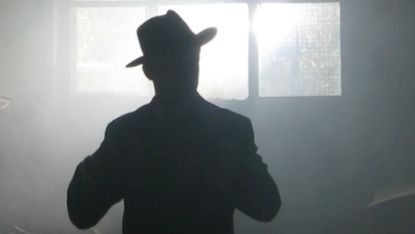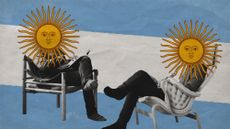Who is the Hat Man? The sleep paralysis nightmare shared around the world
Shadowy figure has become a dominant character in digital culture, fuelled by TikTok’s fascination with the paranormal

Tales of things that go bump in the night are often met with scepticism but one nightmarish figure keeps cropping up in reports from all around the world.
Numerous people claim to have woken in the dark to find a shadowy figure, dubbed the Hat Man, looming over them.
The phenomenon has attracted widespread attention, inspiring documentaries and the launch of a dedicated blog, The Hatman Project, where people can share their experiences.
Subscribe to The Week
Escape your echo chamber. Get the facts behind the news, plus analysis from multiple perspectives.

Sign up for The Week's Free Newsletters
From our morning news briefing to a weekly Good News Newsletter, get the best of The Week delivered directly to your inbox.
From our morning news briefing to a weekly Good News Newsletter, get the best of The Week delivered directly to your inbox.
Something that “probably began with a trick of the light as processed by the human subconscious” has become a “dominant character within the digital culture”, said Rolling Stone. The spooky being has “inspired its own lore and countless witness reports, lately fueled by TikTok’s fascination with the paranormal and occult”.
Who or what is the Hat Man?
It is not a new phenomenon. For about as long as written records have existed, “people have described a frightening night-time vision that paralyses them with fear and seems to suck the breath right out of them, often by pressing directly upon their chest”, reported Quartz.
The “shape of the frightening figure occasionally varies”, but victims usually report feeling “utterly paralyzed with terror, and breathless, as if fear had frozen them from the inside out”, said the site.
The “strange vision” is “remarkably consistent from one account to the next”, added Rolling Stone. “It’s the tall silhouette of a man in a brimmed hat, a presence that tends to appear when you’re in bed at night, somewhere between sleep and consciousness.”
Of course, said the magazine, as more people talk about Hat Man online, the more power the myth obtains and the image becomes self-perpetuating as those “consuming it automatically become disposed to recognize the Hat Man in their own bedrooms”.
What is sleep paralysis?
One in five people have an episode of paralysis at least occasionally, according to the Seattle-based Sleep Foundation, and accompanying hallucinations are very common.
Sleep paralysis blurs the line between sleep and wakefulness, so a person starts to become aware of their surroundings but is still in a state of temporary paralysis called muscle atonia, which the body goes into during rapid eye movement (REM) sleep to protect us from acting out our dreams.
While the exact cause of hallucinations like the Hat Man are unknown, experts believe they “occur when people experience the vivid dreams of REM sleep while they are awake”, said the foundation.
Some say the idea of the Hat Man may be subconscious reworkings of figures from popular culture, including popular horror films in recent times. Christopher French, a psychology professor at Goldsmiths, University of London, said the first thing that came to mind when he thought about the Hat Man was Freddy Krueger from “A Nightmare on Elm Street”. He told Quartz: “This notion that you can be attacked when you’re asleep, that’s when you’re vulnerable. And of course, Krueger wears a hat.”
Writing in the Scientific American, Baland Jalal suggested that people who fear supernatural demons in the night are more likely to experience the phenomenon again. “For centuries, cultures across the world have attributed these hallucinations to black magic, mythical monsters, even paranormal activity,” said Jalal, a researcher at Harvard University's department of psychology.
After comparing how different cultures explain and experience sleep paralysis, he said “it appears that the more people fear sleep paralysis, the more they experience it, and the stronger its effects are”. Accompanied by a belief in the paranormal, sleep paralysis can therefore be not just frightening but potentially traumatising.
“The human mind is vastly more mysterious, and occasionally malevolent, than one would have thought.”
Create an account with the same email registered to your subscription to unlock access.
Sign up for Today's Best Articles in your inbox
A free daily email with the biggest news stories of the day – and the best features from TheWeek.com
-
 Haiti interim council, prime minister sworn in
Haiti interim council, prime minister sworn inSpeed Read Prime Minister Ariel Henry resigns amid surging gang violence
By Peter Weber, The Week US Published
-
 Today's political cartoons - April 26, 2024
Today's political cartoons - April 26, 2024Cartoons Friday's cartoons - teleprompter troubles, presidential immunity, and more
By The Week US Published
-
 Justices set to punt on Trump immunity case
Justices set to punt on Trump immunity caseSpeed Read Conservative justices signaled support for Trump's protection from criminal charges
By Peter Weber, The Week US Published
-
 Nigeria's worsening rate of maternal mortality
Nigeria's worsening rate of maternal mortalityUnder the radar Economic crisis is making hospitals unaffordable, with women increasingly not receiving the care they need
By Harriet Marsden, The Week UK Published
-
 Dengue hits the Americas hard and early
Dengue hits the Americas hard and earlySpeed Read Puerto Rico has declared an epidemic as dengue cases surge
By Peter Weber, The Week US Published
-
 How happy is Finland really?
How happy is Finland really?Today's Big Question Nordic nation tops global happiness survey for seventh year in a row with 'focus on contentment over joy'
By Harriet Marsden, The Week UK Published
-
 How Tehran became the world's nose job capital
How Tehran became the world's nose job capitalUnder the radar Iranian doctors raise alarm over low costs, weak regulation and online influence of 'Western beauty standards'
By Harriet Marsden, The Week UK Published
-
 Africa's renewed battle against female genital mutilation
Africa's renewed battle against female genital mutilationUnder the radar Campaigners call for ban in Sierra Leone after deaths of three girls as coast-to-coast convoy prepares to depart
By Harriet Marsden, The Week UK Published
-
 Argentina: the therapy capital of the world
Argentina: the therapy capital of the worldUnder the radar Buenos Aires natives go hungry to pay for psychoanalysis, amid growing instability, anxiety – and societal acceptance
By Harriet Marsden, The Week UK Published
-
 Does declining birth rate spell doom for Britain?
Does declining birth rate spell doom for Britain?Today's Big Question Ageing population puts pressure on welfare state, economy and fabric of society, while fertility is rising on populist agendas
By Harriet Marsden, The Week UK Published
-
 How a new blood test could revolutionise sepsis diagnosis
How a new blood test could revolutionise sepsis diagnosisThe Explainer Early results from ongoing trial suggest faster identification of deadly condition is possible
By The Week Staff Published